12 Most Sustainable Leggings Brands: The Conscious Consumer’s Guide
Affiliate Disclosure
Hey fellow impactful ninja ?
You may have noticed that Impactful Ninja is all about providing helpful information to make a positive impact on the world and society. And that we love to link back to where we found all the information for each of our posts.
Most of these links are informational-based for you to check out their primary sources with one click.
But some of these links are so-called "affiliate links" to products that we recommend.
Why do we add these product links?
First and foremost, because we believe that they add value to you. For example, when we wrote a post about the environmental impact of long showers, we came across an EPA recommendation to use WaterSense showerheads. So we linked to where you can find them. Or, for many of our posts, we also link to our favorite books on that topic so that you can get a much more holistic overview than one single blog post could provide.
And when there is an affiliate program for these products, we sign up for it. For example, as Amazon Associates, we earn from qualifying purchases.
What do these affiliate links mean for you?
First, and most importantly, we still only recommend products that we believe add value for you.
When you buy something through one of our affiliate links, we may earn a small commission - but at no additional costs to you.
And when you buy something through a link that is not an affiliate link, we won’t receive any commission but we’ll still be happy to have helped you.
What do these affiliate links mean for us?
When we find products that we believe add value to you and the seller has an affiliate program, we sign up for it.
When you buy something through one of our affiliate links, we may earn a small commission (at no extra costs to you).
And at this point in time, all money is reinvested in sharing the most helpful content with you. This includes all operating costs for running this site and the content creation itself.
What does this mean for me personally?
You may have noticed by the way Impactful Ninja is operated that money is not the driving factor behind it. It is a passion project of mine and I love to share helpful information with you to make a positive impact on the world and society. However, it's a project in that I invest a lot of time and also quite some money.
Eventually, my dream is to one day turn this passion project into my full-time job and provide even more helpful information. But that's still a long time to go.
Stay impactful,
Amid growing concerns about the textile industry’s environmental impact, there is pressure to find greener clothes for your wardrobe, from work blazers to workout leggings. Unfortunately, fashion greenwashing makes it harder for you and all other consumers to figure out which clothing brands offer the most eco-friendly garments. So, we had to ask: Which are the most sustainable leggings brands?
The most sustainable leggings brands are Girlfriend Collective, Swedish Stockings, and Happy Earth Apparel, which prioritize recycled and natural fabrics that are low-impact and high-performing while aiming for circularity. In addition, Wolven and Tripulse reduce carbon emissions and textile waste.
Whether you are searching for leggings that meet your workout or loungewear needs to add to your wardrobe without negatively impacting the soil, the water, the animals, and other people, there is a brand for you. So, let’s keep reading to learn more about the most sustainable leggings brands and how they ensure sustainable, ethical practices.
Here’s How We Selected the Most Sustainable Leggings Brands
Leggings can be one of the higher impact and less sustainable clothing items because the stretch and support requirements are often better met by using synthetic fabrics, which release microplastics during use and while washing and don’t biodegrade.
“Sustainable: The ability to be maintained at a certain rate or level | Avoidance of the depletion of natural resources in order to maintain an ecological balance”
Oxford Dictionary
The brands on this list were chosen based on their commitment and actions to promote sustainable practices while reducing the environmental impacts of the textile industry.
They are transparent about their materials, processes, and workforce management within their supply chain.
Some brands focus their efforts on reducing waste and optimizing natural resources while others strive to reduce the carbon footprint of their clothes.
All of these brands share the commitment to reshape the textile industry toward a more sustainable and Earth-friendly sector.
These Are the 12 Most Sustainable Leggings Brands
Most Sustainable Leggings Brands
Overall, these leggings brands are sustainable. Yet, they take various approaches to reduce environmental impacts and uphold ethical standards. Let’s dive into each brand and find out more.
Girlfriend Collective: Essential and Timeless Activewear Made Out of Recycled Materials

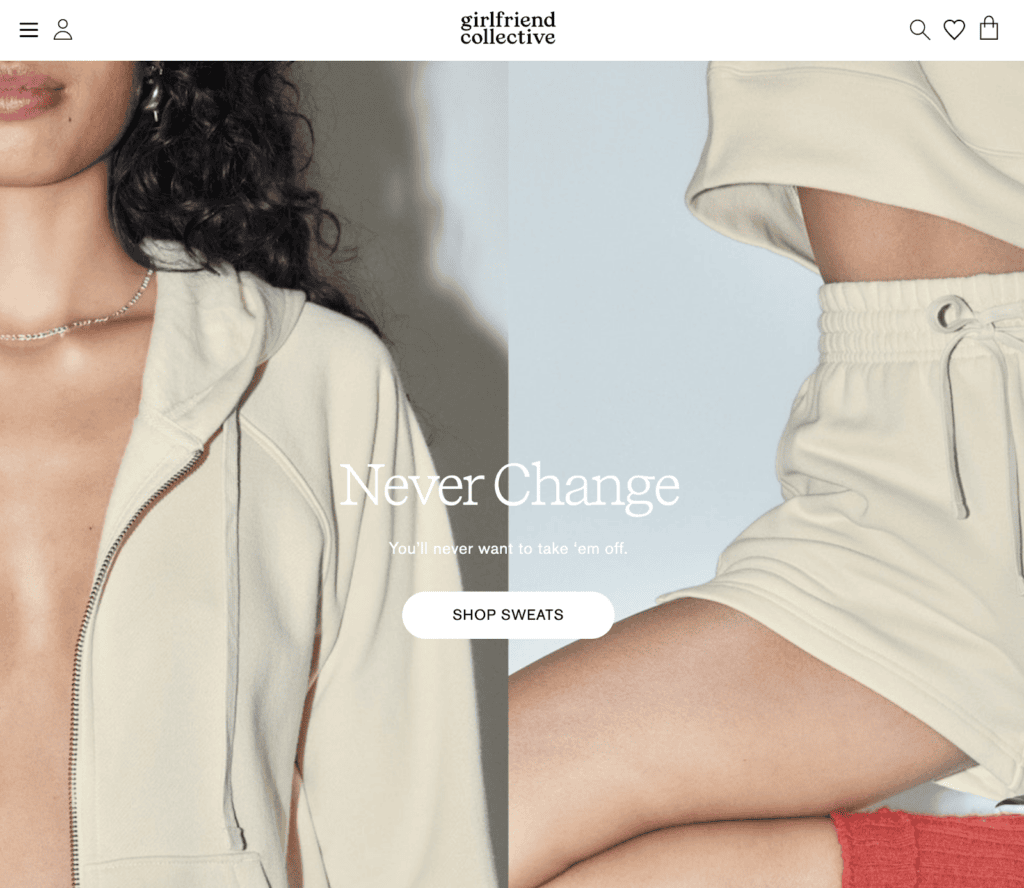
“We make everything locally in small batches to make sure we don’t have a negative impact on the environment.”
Girlfriend Collective
🌎
How do they ensure their sustainability?
Girlfriend Collective’s sustainability efforts start with using recycled and recyclable textile and packing materials.
- Their clothes are made from recycled materials such as post-consumer water bottles, fishing nets retrieved from the seas, fabric scraps, and other waste. On top of that, their packaging is 100% recycled and recyclable. After their clothes are dyed, all the wastewater is sent to a treatment plant 100 feet away. Treated water that meets safety standards is released into the waterway, while mud dye is donated to a pavement facility to be turned into paving stones.
- Additionally, they help prevent microfiber release with a branded microfiber filter. Their program “Recycle. Reuse. Regirlfriend.” collects old Girlfriend Collective compressive leggings and upcycles them into new pieces that can be worn again and again, reducing waste while moving toward a more circular fashion model.
- Lastly, Girlfriend Collective partners with EcoCart to provide a carbon-neutral option for all orders placed on their site to offset the carbon footprint of their products.
🌐
How do they ensure their ethics?
Girlfriend Collective’s facilities are fully certified by Social Accountability International – SA8000. An SA8000 certification guarantees safe working conditions, the right to unionize, and no forced or child labor. They also ensure all workers in their supply chain are paid fair wages and provided with free lunches and guided exercise breaks.
🤝
Are they part of any giving-back programs?
Girlfriend Collective is not known to be part of any giving-back programs.
🛍️
What is their product range?
- Best for: womenswear
- Product range: dresses, hoodies, sweatshirts, activewear, sportswear, maternity wear, tops, blouses, T-shirts, stockings, tights, shorts, lingerie, plus-size
- Price range: $$$
- Size range: 2XS–6XL
Swedish Stockings: Quality Stockings From Recycled Materials

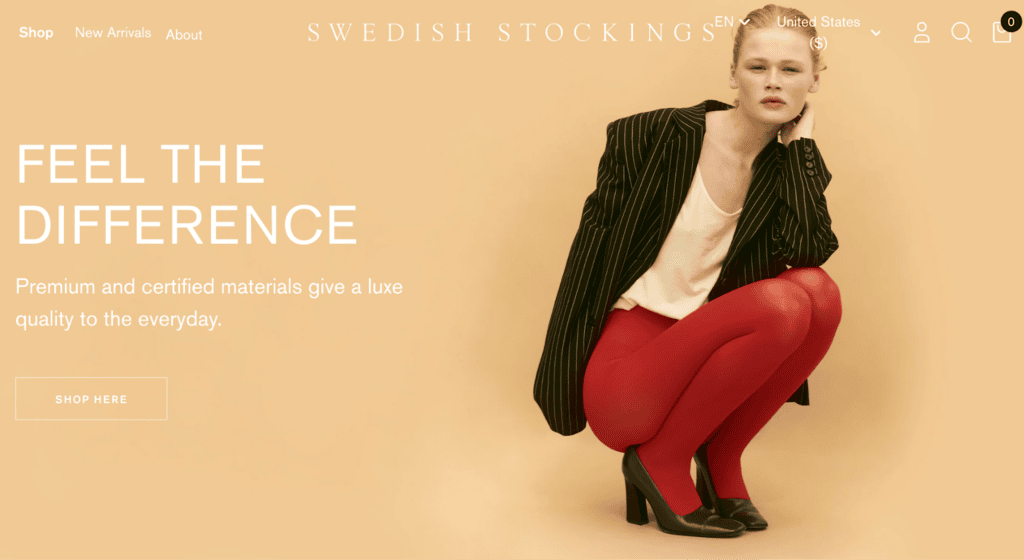
“If we can create a product that women can wear for a longer time, then we can also buy less.”
Linn Frisinger and Nadja Forsberg, Founders of Swedish Stockings
🌎
How do they ensure their sustainability?
Swedish Stockings promotes sustainability by opting for low-impact materials while minimizing waste by recycling their textile offcuts and collecting post-consumer synthetic stockings.
- Instead of sourcing conventional virgin fossil-based polyamide (nylon) for their tights, Swedish Stockings uses high-quality recycled nylon, specifically Aquafil‘s ECONYL®, Fulgar‘s Q-NOVA® and Q-CYCLE®, and Nilit’s SENSIL® Ecocare. They also use bio-based nylon and natural materials (GOTS-certified organic cotton, Responsible-Wool-Standard-certified organic wool, and cashmere).
- While they are not yet able to close their production loop by recycling old hosiery into new products themselves, Swedish Stockings still contributes to reducing textile waste by encouraging consumers to send in their used synthetic pantyhose for a 10% discount code of their products. The collected synthetic pantyhoses are turned into filler materials in tanks and tables. Additionally, Swedish Stockings uses FSC-certified packaging.
- Last but not least, they are transparent about the footprint of their products, disclosing the product journey along the supply chain, including the distance traveled and the cradle-to-gate impacts regarding water scarcity, global warming, eutrophication, and abiotic depletion.
🌐
How do they ensure their ethics?
Swedish Stockings has a Code of Conduct that covers the ILO’s Four Fundamental Freedoms principles.
- They also trace all of their supply chain.
- The final production stage happens in Italian factories with extremely high ethical, social, and environmental standards. They disclose all the supply partners in Italy, including any sustainability and quality certifications granted for such factories.
🤝
Are they part of any giving-back programs?
Swedish Stockings is not known to be part of any giving-back programs.
🛍️
What is their product range?
- Best for: womenswear
- Product range: stockings, tights, socks, leggings, tops, bras
- Price range: $$$
- Size range: XS–XXL
Happy Earth Apparel: Earth-First Organic Clothing Brand
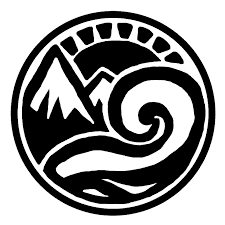
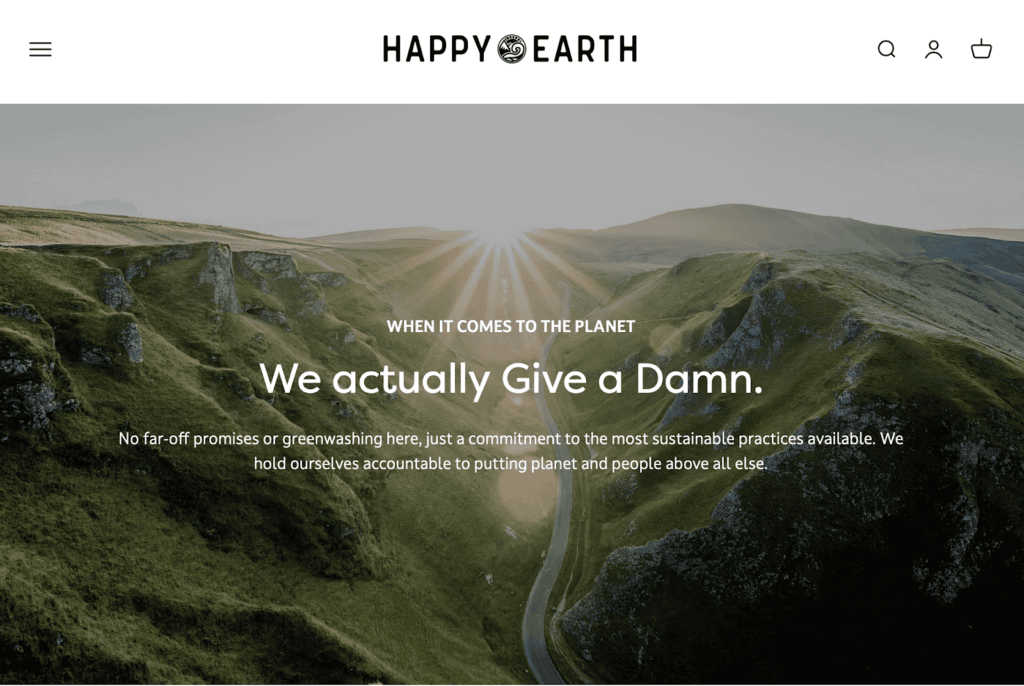
“We’re not cool with compromise when it’s at the expense of our world. We’ll find a good way to do something, or we won’t do it.”
Happy Earth Apparel
🌎
How do they ensure their sustainability?
Happy Earth Apparel ensures sustainability by sourcing sustainable and organic textile materials, using recycled and recyclable packaging, and reducing waste.
- Firstly, Happy Earth Apparel uses a high proportion of organic cotton. For example, their organic sock collection is made with organic cotton that uses a small percentage of recycled nylon and elastane to enhance flexibility and moisture-wicking performance.
- Secondly, they use 100% post-consumer, recycled plastic to make durable packaging bags that can be recycled again. Also, these bags are lightweight, cutting down on transporting emissions and costs.
- Lastly, Happy Earth Apparel has waste-reduction incentives regarding plastic (shipping in bulk), water (wastewater recycling and rain harvesting), and textile (low-waste cutting techniques). Furthermore, Happy Earth Apparel is Climate Neutral Certified for reducing and offsetting their emissions. They also use solar energy in their supply chain to reduce their carbon emissions. Regarding emissions that can’t be avoided, they offset through clean energy projects in the US, Uganda, India, and China. These include providing energy-efficient stoves, capturing methane, and installing biodigesters in rural homes that convert manure waste into gas for cooking.
🌐
How do they ensure their ethics?
Happy Earth Apparel ensures their ethics by binding suppliers with a Code of Conduct covering four of ILO’s Fundamental Principles and Rights at Work. Additionally, over 95% of their products are made in Fairtrade-certified factories, while part of their final production stage is certified by Worldwide Responsible Accredited Production (WRAP). Finally, Happy Earth Apparel traces most of their supply chain.
🤝
Are they part of any giving-back programs?
Happy Earth Apparel actively participates in giving-back programs. As a member of 1% for the Planet, Happy Earth Apparel is committed to donating a minimum of 1% of their revenue to charitable organizations through their Tree Planting, Climate Change, and Trash Clean-Up projects. For example, customers can choose to plant five trees for every purchase.
🛍️
What is their product range?
- Best for: womenswear, menswear
- Product range: shirts, T-shirts, sweatshirts, hoodies, jackets, bottoms, dresses, pants, leggings, shorts, socks, accessories
- Price range: $$
- Size range: XXS–XXL
Wolven: Multifunctional Activewear Made From Recycled Bottles
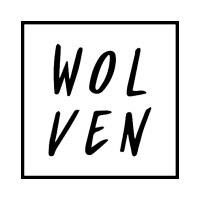

“Sustainability to us means every decision we make is rooted in our intention to protect our planet and create a more equitable and Earth-centered future for all.”
Amanda Lapham, Co-founder of Wolven
🌎
How do they ensure their sustainability?
Wolven ensures their sustainability by sourcing a high proportion of low-impact fabrics.
- Specifically, all of their 2022 swimwear and activewear was made with 84% recycled polyester fabrics reclaimed from discarded plastic water bottles. Their recycled fabrics are certified with the Global Recycled Standard and OEKO-TEX® STANDARD 100.
- Additionally, they design their clothes to be reversible and multifunctional so customers can do more and buy less. Regarding their climate impact, Wolven is certified Climate Neutral for reducing and offsetting their carbon emissions.
- They also reduce their impact by using emission-free renewable energy in the supply chain and at their office, opting for sea freight shipping over air freight, and recycling packaging materials to reduce waste. Regarding the necessary emissions, they compensate by investing in projects in wind energy and reforestation.
- Lastly, they further their commitment to circular fashion beyond using recycled material with their resale program, Wolven Pre-Loved.
🌐
How do they ensure their ethics?
Wolven only traces part of their supply chain. Their manufacturing partner is based in China and assessed by Intertek as conforming to the requirements of the Workplace Conditions Assessment.
🤝
Are they part of any giving-back programs?
Wolven gives back 1% of their annual revenue to nonprofit organizations. For example, each purchase from their Neutral Collection gives back to Climate Neutral through their1% for the Planet membership. They also partner with CleanHub to organize events to pick up plastic bottles and clean up places like beaches, rivers, and canals.
🛍️
What is their product range?
- Best for: womenswear, menswear
- Product range: one-piece swimwear, bikinis, tops, tees, sweatshirts, leggings, flares, shorts, joggers
- Price range: $$
- Size range: XS–XL
Tripulse: Activewear Made Sustainable With Certified Eucalyptus Wood Fiber

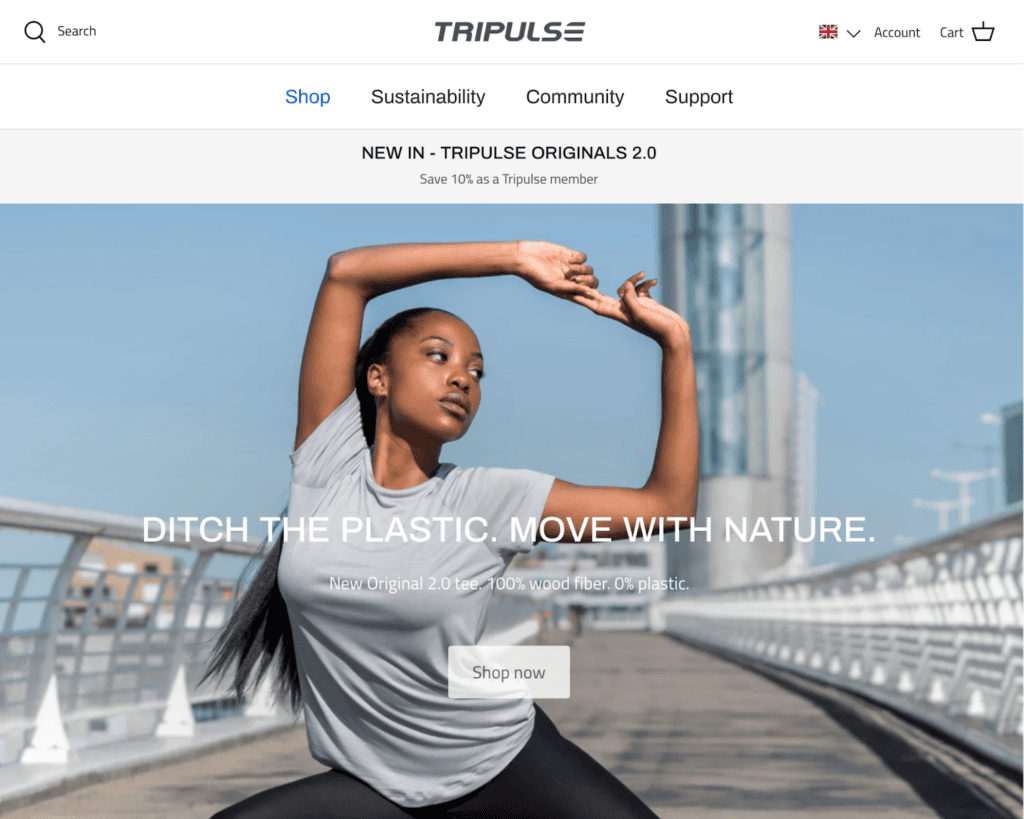
“Sustainability is at the heart of everything we do and of every decision we make. It’s part of our DNA.”
Franziska Mesche, Founder of Tripulse
🌎
How do they ensure their sustainability?
Tripulse ensures sustainability by sourcing low-impact materials, reducing waste, and overcompensating their carbon emission to be climate-positive.
- Firstly, they use a high proportion of TENCELTM lyocell made with certified eucalyptus wood fibers. Tripulse also opts for ROICA™ V550, a more eco-friendly stretch alternative to spandex (elastane), for the stretch element necessary in gym workout leggings. Furthermore, the elastane found in a small percentage of Tripulse’s Power III fabric blend consumes less energy, requires lower CO2 emissions than conventional elastane, and has various sustainability certifications (Bluesign®, OEKO-TEX®, and REACH). On top of that, they use organic cotton and natural rubber for elements like care labels and waistbands.
- Secondly, Tripulse reduces waste by designing timeless, versatile, and multifunctional garments that are durable and long-lasting, using recycled and recyclable packaging materials, and keeping clothing with minor blemishes, prototypes, or returned and refreshed clothing in circulation with their ZeroWaste Shop.
- Last but not least, the brand holds climate action at the center of their operation, measuring, reducing, offsetting, and overcompensating their carbon emissions. On top of using low-carbon materials and reducing waste, they offset more than their emissions in projects preventing deforestation in biodiverse areas.
🌐
How do they ensure their ethics?
Tripulse ensures their ethics by partnering with a factory certified by the Global Organic Textile Standards and paying a living wage in the final stage of their production. They are also transparent about the rest of their supply chain, publicly sharing their suppliers for various components.
🤝
Are they part of any giving-back programs?
Tripulse plants a tree for every product purchased via their partnership with One Tree Planted.
🛍️
What is their product range?
- Best for: womenswear
- Product range: leggings, tops, T-shirts, tank tops
- Price range: $$$
- Size range: XXS–3XL
Groceries Apparel: Clothes Using Non-Toxic Dyes

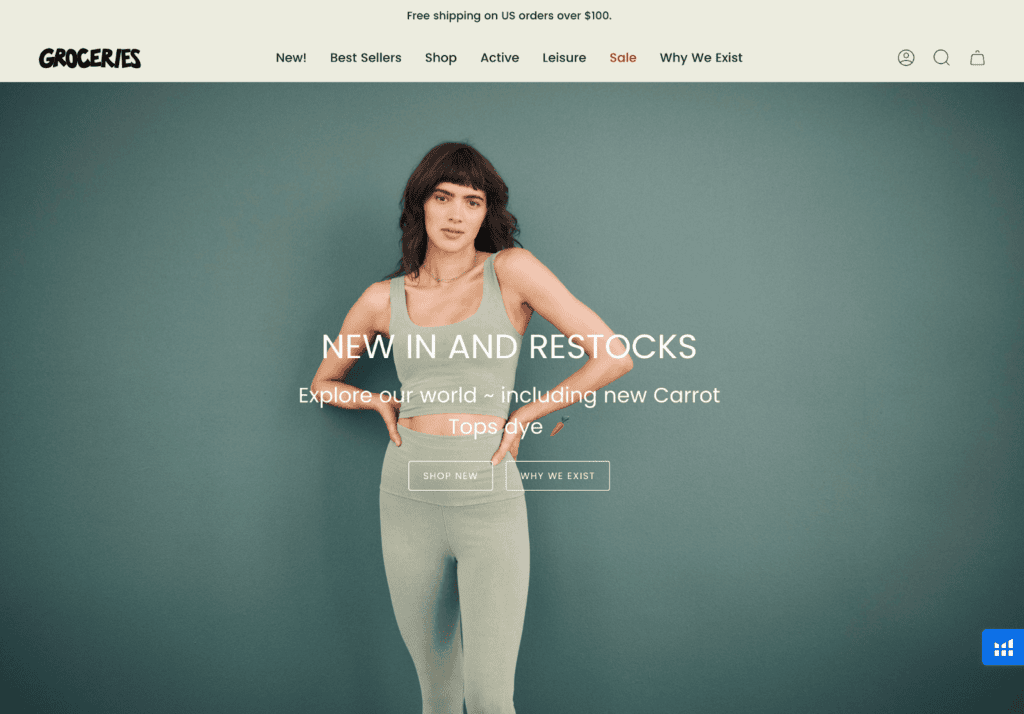
“We lead a new generation of clothing brands that manufacture their own garments in full transparency”
Groceries Apparel
🌎
How do they ensure their sustainability?
Groceries Apparel prioritizes sustainability by sourcing organic and non-toxic materials.
- They have completely eliminated heavy metals and toxic chemicals from their supply chain. All their clothes are dyed with plant-based dyestuff, including food waste such as onion skins, carrot tops, and avocado pits and skins.
- Groceries Apparel uses a high proportion of lower-impact fabrics, including GOTS-certified organic cotton and TENCEL™ sourced from sustainably harvested trees.
- Their entire manufacturing process, from design, digitizing, marking, cutting, sewing, and dyeing, to finishing and shipping, happens in their Los Angeles-based clothing factory, reducing transportation emissions.
🌐
How do they ensure their ethics?
Groceries Apparel is fully transparent about their Los Angeles factory, ensuring fair wages and good working conditions. They also trace most of their supply.
🤝
Are they part of any giving-back programs?
Groceries Apparel is not known to be part of any giving-back programs.
🛍️
What is their product range?
- Best for: womenswear, menswear, kidswear
- Product range: T-shirts, tops, blouses, dresses, shorts, skirts, stockings, tights, underwear
- Price range: $$
- Size range: XS–XL
ARMEDANGELS: Sustainable Clothing Brand Plus an Agent of Lifestyle Change


“So starting out with the humble tee, we took our oath against wage slavery, chemical shortcuts, and mass-producing pure crap, and transformed ourselves into one of the first clothing brands in all the land to put people and planet first.”
ARMEDANGELS
🌎
How do they ensure their sustainability?
ARMEDANGELS ensures sustainability by reducing carbon footprints while enabling people to change their lifestyles to fight climate change.
- The brand innovates to cut down carbon emissions in their supply chain, starting with sourcing a high proportion of eco-friendly materials. Specifically, they use GOTS-certified organic cotton fabrics, GRS-certified recycled fabrics, GOTS-and RWS-certified organic wool fabrics, and FSC/PEFC-certified wood-based fabrics like TENCELTM Modal.
- Additionally, ARMEDANGELS chooses materials with the lowest carbon footprint possible, for example, opting for modal and lyocell over silk or natural fabrics over fossil-based synthetic fabrics while increasing recycled content, such as recycled wool and recycled cotton. For example, within a year, the share of recycled cotton in their DetoxDenim jeans increased from 5% to 37%, with some jeans in the collection containing 100% recycled cotton.
- Lastly, ARMEDANGELS’s efforts to encourage lifestyle change include care and repair guides to keep garments in circulation longer. They also have a resale platform that facilitates traded-in items to be sold again as second-hand clothes or recycled as fibers for new clothes.
🌐
How do they ensure their ethics?
ARMEDANGELS ensures their ethics by only working with trusted partners to deliver decent wages and workers’ safety.
- They directly and actively monitor all their suppliers and the suppliers’ nominated subcontractors via an on-site and online Internal Due Diligence Check and Self-Assessment, external audits by Fair Wear Foundation (FWF), Global Organic Textile Standard and third-party audits, continuous support, and tailored training programs by third parties.
- On top of that, ARMEDANGELS ensures payment of a living wage in part of their supply chain and pays a markup where they notice wage issues via the living wage project.
- Most importantly, they are fully transparent about the journey from raw material to their products, especially where people and animals are involved, and the impacts of their actions.
🤝
Are they part of any giving-back programs?
ARMEDANGELS raises funds by donating part of their sales to support various organizations and campaigns. For example, during the COVID-19 pandemic, they raised €745.800 ($790,883.61 USD) for Doctors Without Borders, facilitating isolation wards, COVID-19 clinics, and protective clothing for medical professionals worldwide. Other fundraising projects include supporting the climate movement with German Zero and the Climate Emergency Fund, fighting for equality with UN Women, advocating for fair payment and safe working conditions for Bangladeshi garment workers with the National Garment Workers Federation, and rescuing refugees in the Mediterranean Sea with Sea-Watch.
🛍️
What is their product range?
- Best for: kidswear, menswear
- Product range: denim jeans, jackets, jumpsuits, shorts, skirts, T-shirts
- Price range: $$
- Size range: XS–XXL
Organic Basics: A Carbon Neutral Brand Creating Underwear, Activewear, and Everyday Essentials


“We make our basics to be both Earth- and people-friendly — carefully choosing materials and fabrics that care for our environment, only partnering with factories that consider their impact too, and designing all the basics for all bodies.”
Organic Basics
🌎
How do they ensure their sustainability?
Organic Basics promotes sustainability by choosing fabrics based on their environmental footprint and lifetime durability.
- Their clothes are made organic fabrics (cotton certified by the Global Organic Textile Standard), low-impact textiles (TENCEL™ lyocell certified by the STANDARD 100 by OEKO-TEX®), or recycled materials (recycled wool, recycled cotton, and recycled nylon). They use a small percentage of elastane (spandex) in some garments to extend the products’ longevity, which ultimately extends the lifespan.
- Organic Basics is fully transparent about the impact of their products, enabling consumers to understand their share in using the clothes. Organic Basics partners with Made2Flow, which calculates their emissions, and One Carbon World, which helps them reduce and offset all their emissions.
- Finally, they are also a B Corporation.
🌐
How do they ensure their ethics?
Organic Basics works only with trusted, certified factory partners, who ensure that their workplace is free of child labor and forced labor and that their workers enjoy a safe working space, earn a living wage, and benefit from employee perks like free lunches and childcare.
- They show full transparency of the location and practices in their factories.
- Organic Basics also audits or visits most of their suppliers.
🤝
Are they part of any giving-back programs?
Organic Basics donates 1% of the value of all orders to sustainable projects. Their partnership with Beam Impact enables consumers to choose where their 1% donation will go—at no extra cost to the consumers—to support local charities that help Nature Conservation, Ocean Conservation, Rewilding, or Sustainability & Gender Equity.
🛍️
What is their product range?
- Best for: womenswear, menswear
- Product range: underwear, bras, bottoms, T-shirts, tops, sweatshirts, hoodies, knitwear dresses, swimwear, socks, plus-size
- Price range: $$$
- Size range: XXS–XXL
Threads 4 Thought: Everyday Basics Produced Responsibly

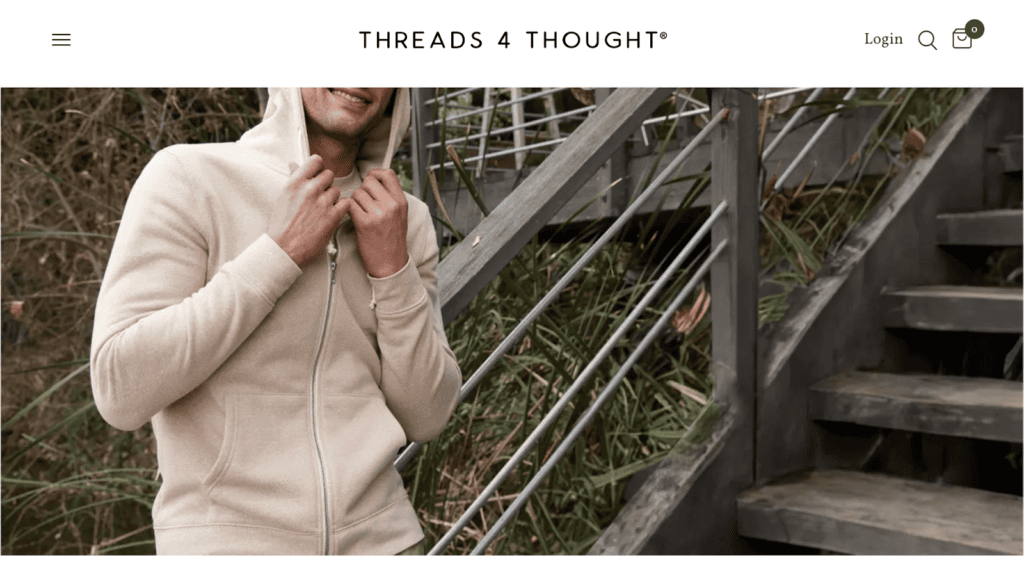
“From our original designs to our fabrics to the factory floor, we are committed to leaving an innately smaller impact on our planet.”
Threads 4 Thought
🌎
How do they ensure their sustainability?
Threads 4 Thought promotes sustainability by sourcing a high proportion of eco-friendly materials including recycled polyester, organic cotton, and modal with Lenzing’s renewable beech tree pulp.
- For example, the Madge Feather Fleece Hoodie contains 95% LENZING™ Modal. Further down the life-cycle in manufacturing, they lower their environmental impacts by implementing a dye technology that eliminates all harmful chemicals and reduces water usage during the dyeing process by 95%.
- They also recycle 80% of their main factory’s industrial wastewater. Additionally, their packing materials are fully FSC-certified, with 90% being WaveBags, which are 100% recyclable, water resistant, and strong.
- Lastly, 99% of their products are transported by boat rather than air, reducing carbon emissions during the transportation stage.
🌐
How do they ensure their ethics?
Threads 4 Thought traces most of their supply chain and reduces their impact through Greenstory. They have a Supplier Code of Conduct that covers all ILO’s Fundamental Freedoms.
🤝
Are they part of any giving-back programs?
Threads 4 Thought partners with the International Rescue Committee to help people displaced due to various conflicts.
🛍️
What is their product range?
- Best for: menswear, womenswear, kidswear
- Product range: sweaters, dresses, pants, jackets, blazers, shorts, hoodies, sweatshirts, T-shirts, tops, blouses, maternity, stockings, tights, jumpsuits, playsuits, sportswear, sleepwear, accessories, plus-size
- Price range: $$
- Size range: XS–XXL
Silou: Luxurious and Sustainable Active Clothing


“We strive to be 100% accountable for our sustainable measures—starting with product creation and production, to how our products are packaged and shipped all around the world.”
Silou
🌎
How do they ensure their sustainability?
Silou is committed to using non-toxic and sustainably sourced and manufactured materials.
- They source a high proportion of lower-impact materials, including organic cotton under the Better Cotton Initiative, TENCELTM, and recycled nylon (ECONYL®). Additionally, all their products are certified by OEKO-TEX®, meaning that every component of every garment, from button to thread, has been tested for harmful substances and, therefore, is harmless for human health.
- Silou also opts to work with fabric mills that utilize solar energy to power weaving looms and recycle all waste material, including water, reducing the environmental impacts of their textile materials. Further down the life-cycle in the clothing manufacturing stage, they produce yoga leggings and bras in small batches to avoid overproduction, fast fashion, landfilling, and return culture.
- Lastly, they use some recycled packaging.
🌐
How do they ensure their ethics?
Silou states that they trace all of their supply chain and make regular visits to their suppliers and factories to ensure their standards adhere to the best standards. Their manufacturing partners are located in Lithuania, Belarus, Portugal, and Italy.
🤝
Are they part of any giving-back programs?
Silou is not known to be part of any giving-back programs.
🛍️
What is their product range?
- Best for: womenswear
- Product range: sports bras, leggings, tops, T-shirts, bodysuits, tracksuit bottoms, sweatshirts, shorts, accessories
- Price range: $$$
- Size range: XXS–L
Pact: Stylish, Comfortable, Essential Clothing Made Ethically and Sustainably

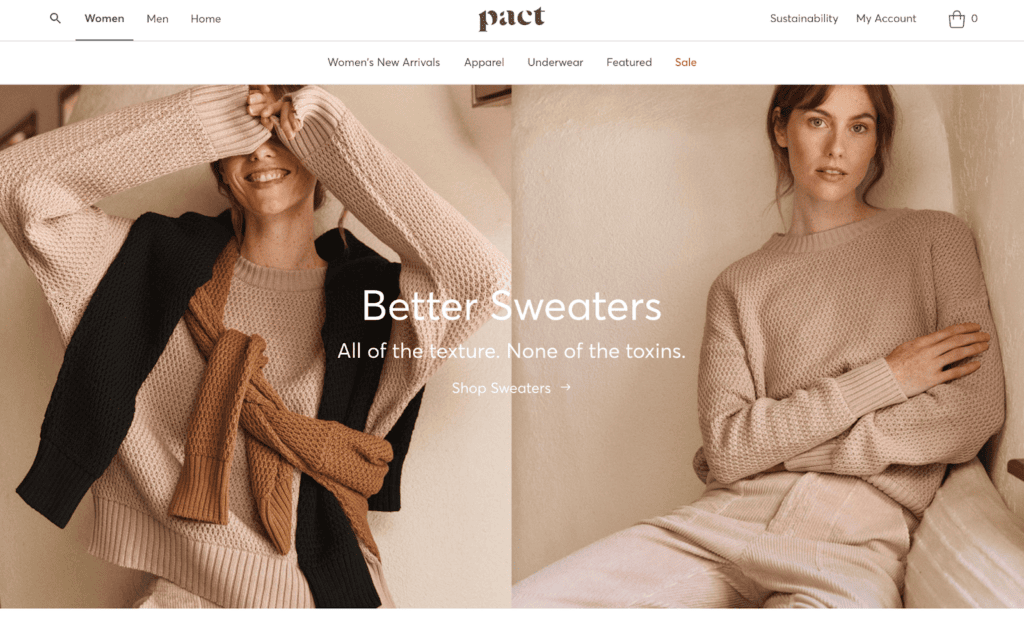
“We believe the planet, and the people on it, should always come first in fashion.”
Pact
🌎
How do they ensure their sustainability?
Pact ensures sustainability by using low-impact textile and packaging materials, offsetting the carbon impact of all their products, and facilitating the donation of used clothes to reduce waste.
- They use a high proportion of eco-friendly fabrics, including organic fabrics made with GOTS-certified cotton.
- Additionally, their clothes are delivered in VelaTM paper bags. These bags are made with carbon-neutral, FSC-certified, recyclable paper.
- Pact also partners up with SimpliZero. This partnership enables measuring the impact of every product Pact makes and offsetting it through reforestation, renewable energy, and community projects sequestering carbon from the atmosphere.
- Their Give Back Box incentive enables their customers to reuse the boxes their Pact orders came in and donate their used clothes to local charities with the postal fee paid for by Pact.
🌐
How do they ensure their ethics?
Pact uses Fair Trade CertifiedTM factories, providing safe working conditions, community support, and additional development funds to workers in their supply chain. They also trace most of their supply chain, including all of the final stages of production.
🤝
Are they part of any giving-back programs?
Pact is not known to be part of any giving-back programs.
🛍️
What is their product range?
- Best for: womenswear, menswear
- Product range: dresses, hoodies, sweatshirts, activewear, sleepwear, maternity wear, T-shirts, underwear, jumpsuits, playsuits, plus-size
- Price range: $$$
Asquith: Ethically Made Garments For Yoga, Pilates, and Living In


“We do our best for our planet, customers and employees, at every step along our journey..”
Asquith
🌎
How do they ensure their sustainability?
Asquith ensures sustainability by sourcing low-impact textile and packaging materials.
- They source eco-friendly plant-based fabrics, including organic cotton, TENCEL™ Modal, and a textile blend of organic cotton, bamboo, and a small amount of elastane (Bambor®). Asquith also uses OEKO-TEX®-certified viscose fabrics derived from sustainably cultivated bamboo.
- The dyes they use comply with GOTS and OEKO-TEX® standards. Regarding packaging, Asquith uses no plastics. Their garment bags are made with corn, sugar cane, and potatoes; they are, therefore, renewable, compostable, and biodegradable.
- The materials for their swing tags and catalogs are recycled and recyclable.
🌐
How do they ensure their ethics?
Asquith ensures their ethics by partnering with a GOTS-certified factory for the final stage of production. The factory is audited by SMETA, guaranteeing social standards, environmental conditions, business ethics, and adherence to health and safety procedures.
🤝
Are they part of any giving-back programs?
Asquith commits to supporting the Prince’s Trust, donating to help young people develop the skills and confidence they need to find a job or start a business.
🛍️
What is their product range?
- Best for: womenswear
- Product range: leggings, pants, bras, vests, hoodies, sweatshirts, dresses, skirts
- Price range: $$
- Size range: XS–XXL
Why Is It Important to Buy Products Made of More Sustainable Fabrics
It is important to buy products made of more sustainable fabrics because a sustainable textile industry has a lower carbon footprint, helps save natural resources, and is better for forests, animals, and humans.
Buying Sustainable Fabrics Reduces Your Carbon Footprint
The production of clothing and footwear is estimated to contribute 10% of global greenhouse gas emissions—more than all international flights and shipping combined. If the fashion industry were a country, it would be the fourth largest emitter of carbon dioxide.
One way to reduce the carbon footprint of the clothes you buy is to opt for sustainable fabrics. Sustainable fabrics, which are often made with natural or recycled fibers, have relatively low carbon footprints compared to petroleum-based fabrics. For example, organic cotton made in the US has a carbon footprint of 2.35 kg CO2 (per ton of spun fiber)—a quarter of polyester’s carbon footprint.
Buying Sustainable Fabrics Reduces Demand For Natural Resources and Waste Management
The textile industry uses water and land to grow cotton and other fibers. It is estimated that 79 billion cubic meters of water were used for the sector worldwide in 2015. For example, producing a single cotton T-shirt requires as much water as one person drinks for 2.5 years (2,700 liters of fresh water).
Worse yet, the textile economy is vastly more linear than circular: the largest amount of resources used in clothes ended up in landfills (instead of being recycled to remake clothes). According to a report by the Ellen MacArthur Foundation,
- Less than 3% of materials used in the textile economy in 2015 came from recycled sources.
- In other words, more than 97% of resources used in making clothes are newly extracted.
When clothing items are disposed of within a short period of time—under a year in the case of half of the fast fashion clothes—the natural systems that provide raw materials for fabrics don’t have enough time to recover and regenerate, which could lead to ecological breakdown.
Sustainable fabrics are made with less water and emissions while lasting longer:
- Because they are durable, you don’t need to buy new clothes too often.
- Thus, you help reduce the pressure to extract more resources for making new items.
Similarly, making and consuming sustainable fabrics made with recycled materials reduces the demand for virgin materials while helping tackle waste management.
Buying Sustainable Fabrics Encourages Sustainable Management of Forests
Sustainable natural fiber fabrics are made with raw materials from forests and plantations that are sustainably managed, such as complying with FSC standards.
When you buy sustainable natural fiber fabrics, you discourage unsustainable forestry practices like illegal logging. You can help reduce deforestation, biodiversity loss, and the effects of climate change.
Buying Sustainable Fabrics Encourages Fairer Treatment of Animals
The fashion industry is rife with animal mistreatment when it comes to making animal-based fabrics like wool or silk. Every year, billions of animals suffer and die for clothing and accessories.
Buying sustainable vegan alternatives can help to reduce the pressure on raising more and more animals to meet the demand for animal-based fabrics while sacrificing their well-being and lives.
Suppose you have to buy fabrics made with, for example, wool or silk; make sure you only choose brands committed to cruelty-free products. In that case, you help advocate better treatments for animals raised within the textile industry.
Using Sustainable Fabrics Encourages Fairer Treatment of Textile Workers
Recent statistics from UNICEF estimated as many as 170 million child laborers worldwide, many of whom were engaged in some form of work in the textile industry. They don’t get paid minimum wages and often work long hours.
When you buy sustainable fabrics from brands that are transparent about the working conditions at their factories, you discourage the use of child labor and help promote better working conditions for textile workers.
How Can You Generally Buy More Sustainable Fabrics
The key to sustainably buying fabrics is to check on relevant environmental and original certifications.
For natural fabrics:
- Global Organic Textile Standard (GOTS): A globally recognized certification system that ensures a certain threshold of organic content has been met. It covers manufacturing, packaging, labeling, transportation, and distribution (but not what happens in the fields where crops are grown).
- USDA Certified Biobased Product: The USDA BioPreferred® Certification is a voluntary certification offered by the United States Department of Agriculture. The certification identifies products made from plants or other renewable materials.
- Ecolabel: Ecolabel is the official European Union voluntary label recognized worldwide for certified products with a guaranteed, independently verified low environmental impact. The label requires high environmental standards throughout the entire life-cycle: from raw material extraction through production and distribution to disposal. It also encourages companies to develop innovative, durable, easy-to-repair, and recyclable products.
For natural fiber semi-natural/semi-synthetic fabrics:
- Forest Stewardship Council: An FSC certification ensures that the wood (or wood-like material) comes from responsibly managed forests that provide environmental, social, and economic benefits.
There are two types of FSC Certification:- FSC Forest Management Certification, with a focus on the origin of the wood—the forest.
- FSC Chain of Custody Certification, which focuses on the path from the forest to the customer’s home.
- Program for Endorsement of Forest Certification: PEFC’s approaches to sustainable forest management are in line with protecting the forests globally and locally and making the certificate work for everyone. Getting a PEFC certification is strict enough to ensure the sustainable management of a forest is socially just, ecologically sound, and economically viable but attainable not only by big but small forest owners.
For recycled fabrics:
- Recycled Claim Standard (RCS): The Textile Exchange RCS was originally developed as an international, voluntary standard that sets requirements for third-party certification of Recycled input and chain of custody.
- The Global Recycled Standard (GRS): The Global Recycled Standard (GRS) is an international, voluntary, full product standard that sets requirements for third-party certification of Recycled Content, chain of custody, social and environmental practices, and chemical restrictions. It can be used for any product with more than 20% recycled material.
For all types of fabrics:
- STeP by OEKO-TEX®: STeP by OEKO-TEX® is an independent certification system for brands, retailers, and manufacturers from the textile and leather industry. It communicates organizational environmental measures, including reducing carbon footprint and water usage.
- OEKO-TEX® Standard 100: OEKO-TEX® labels aim to ensure that products pose no risk to human health (i.e., containing banned chemicals).
Some certifications that are signaling brands’ efforts toward lowered environmental impacts and a circular economy are:
- B Corp Certification: The label B Corp is a certification reserved for for-profit companies. Certified holders are assessed on their social and environmental impacts.
- Cradle2Cradle certification: Cradle2Cradle provides a standardized approach to material circularity. It assesses whether products have been suitably designed and made with the circular economy in mind covering five critical categories: material health, material reuse, renewable energy and carbon management, water stewardship, and social fairness.
Final Thoughts
Leggings can often be a high-impact item due to the conventional use of synthetic fabrics for stretch and moisture wicking. Thus, it is important to shop with ethics and sustainability in mind when choosing your next pair of leggings.
By purchasing leggings from brands that commit to sustainability, you support their mission to create a fairer and less harmful textile industry for all lives on Earth.
Here is the list (again) of the most sustainable leggings brands:
- Girlfriend Collective
- Swedish Stockings
- Happy Earth Apparel
- Wolven
- Tripulse
- Groceries Apparel
- ARMEDANGELS
- Organic Basics
- Threads 4 Thoughts
- Silou
- Pact
- Asquith
To make your use of these clothing items even more sustainable, follow these steps:
- Buy recycled or upcycled leggings made with low-impact materials.
- Keep your leggings for as long as possible.
- At the end-of-life of your leggings, upcycle the materials to extend their usage and arrange for them to be recycled or properly disposed of.
Stay impactful,

Sources
- Impactful Ninja: How Sustainable Are Synthetic Fabrics? A Life-Cycle Analysis
- Science Direct: Life-cycle assessment (LCA)
- Girlfriend Collective: Home
- Swedish Stockings: Home
- Happy Earth Apparel: Home
- Wolven: Home
- Tripulse: Home
- Groceries Apparel: Home
- ARMEDANGELS: Home
- Organic Basics: Home
- Threads 4 Thought: Home
- Silou: Home
- Pact: Home
- Asquith: Home
- Girlfriend Collective: Leggings
- Girlfriend Collective: About
- Girlfriend Collective: How is your recycled fabric made?
- Girlfriend Collective: Is everything eco-friendly?
- Girlfriend Collective: The Microfiber Filter
- Girlfriend Collective: Recycle. Reuse. Regirlfriend
- EcoCart: Home
- Girlfriend Collective: Are you carbon-neutral
- Good On You: Brand Directory | Girlfriend Collective
- SA8000 Standards: Home
- Swedish Stockings: Leggings
- Swedish Stockings: Materials
- Good On You: Brand Directory | Swedish Stockings
- Swedish Stockings: Recycling Club
- Impactful Ninja: How Sustainable Are Polyamide Fabrics? A Life-Cycle Analysis
- Impactful Ninja: How Sustainable Are Nylon Fabrics? A Life-Cycle Analysis
- Impactful Ninja: How Sustainable Are Recycled Nylon Fabrics? A Life-Cycle Analysis
- Aquafil: Home
- Impactful Ninja: How Sustainable Are ECONYL® Fabrics? A Life-Cycle Analysis
- Fulgar: Home
- Fulgar: Q-NOVA® by Fulgar
- Fulgar: Q-CYCLE® by Fulgar
- Nilit: SENSIL® Ecocare
- Global Organic Textile Standard: Home
- Impactful Ninja: How Sustainable Are Organic Cotton Fabrics? A Life-Cycle Analysis
- Textile Exchange: Responsible-Wool-Standard
- Impactful Ninja: How Sustainable Are Organic Wool Fabrics? A Life-Cycle Analysis
- Impactful Ninja: How Sustainable Are Cashmere Fabrics? A Life-Cycle Analysis
- B Corporation: Swedish Stockings
- Swedish Stockings: Sustainability
- Swedish Stockings: Supplier Code of Conduct
- International Labor Organization (ILO): Fundamental Principles and Rights at Work
- Swedish Stockings: Factories
- CHANGE CLIMATE: Tripulse is Climate Neutral Certified
- B Corporation: Happy Earth Apparel
- Happy Earth Apparel: PlantTecTM bottoms
- Happy Earth Apparel: About Us
- Good On You: Brand Directory | Happy Earth Apparel
- Happy Earth Apparel: Organic socks
- Change Climate: Happy Earth LLC | A Climate Neutral Certified Brand
- Happy Earth Apparel: Supporting Carbon Emissions Reduction
- Happy Earth Apparel: Code of Conduct
- Worldwide Responsible Accredited Production: Home
- Happy Earth Apparel: Tree Planting
- Good On You: Brand Directory | Wolven
- Wolven: Turmeric Active Top
- Wolven: 2023 Impact Report
- Wolven: Raina Legging
- Impactful Ninja: How Sustainable Are Recycled Polyester Fabrics? A Life-Cycle Analysis
- Impactful Ninja: How Sustainable Are Spandex Fabrics? A Life-Cycle Analysis
- Impactful Ninja: How Sustainable Are Elastane Fabrics? A Life-Cycle Analysis
- Impactful Ninja: How Sustainable Are Recycled Fabrics? A Life-Cycle Analysis
- Textile Exchange: Global Recycled Standard
- OEKO-TEX: OEKO-TEX STANDARD 100
- CHANGE CLIMATE: Wolven is Climate Neutral Certified
- Good On You: Brand Directory | Wolven
- Treet: Wolven Pre-Loved
- Intertek: Home
- LinkedIn: Wolven
- Wolven: Neutral Collection
- Climate Neutral: Home
- CleanHub: Home
- Tripulse: Materials & Trims
- Tripulse: WE’RE CLIMATE NEUTRAL CERTIFIED FOR 2023!
- Tripulse: Climate Action
- Good On You: Brand Directory | Tripulse
- Impactful Ninja: How Sustainable Are TENCEL Fabrics? A Life-Cycle Analysis
- ASAHI KASEI: ROICA
- THE SLOW LABEL: The problem with Elastane: ROICA™ V550 is an alternative
- Impactful Ninja: How Sustainable Are Spandex Fabrics? A Life-Cycle Analysis
- Impactful Ninja: How Sustainable Are Elastane Fabrics? A Life-Cycle Analysis
- Bluesign: Home
- European Union: REACH Regulation
- Impactful Ninja: How Sustainable Are Organic Cotton Fabrics? A Life-Cycle Analysis
- Tripulse: Design Philosophy
- Tripulse: Packaging and transportation
- Tripulse: OUR WAY TO ZERO WASTE
- Tripulse: ZeroWaste Shop
- Global Organic Textile Standards: Home
- Tripulse: Ethical & transparent supply chain
- Tripulse: WHY WE PLANT TREES WITH EVERY PRODUCT PURCHASED
- One Tree Planted: Home
- Groceries Apparel: Bottoms
- Groceries Apparel: Why We Exist
- Groceries Apparel: Upcycled Avocado Dye
- Good On You: Brand Directory | Groceries Apparel
- ARMEDANGELS: Activewear
- Good On You: Brand Directory | ARMEDANGELS
- ARMEDANGELS: THE JOURNEY FROM RAW MATERIAL TO PRODUCT | A T-Shirt Made from Organic Cotton
- Impactful Ninja: How Sustainable Are Organic Cotton Fabrics? A Life-Cycle Analysis
- Impactful Ninja: How Sustainable Are Recycled Fabrics? A Life-Cycle Analysis
- Global Organic Textile Standard (GOTS): Home
- Impactful Ninja: How Sustainable Are Organic Wool Fabrics? A Life-Cycle Analysis
- Forest Stewardship Council: Home
- Programme for the Endorsement of Forest Certification: Home
- Impactful Ninja: How Sustainable Are Wood-Based Fabrics? A Life-Cycle Analysis
- ARMEDANGELS: THE JOURNEY FROM RAW MATERIAL TO PRODUCT | Recycling
- ARMEDANGELS: About Us
- Impactful Ninja: How Sustainable Are Silk Fabrics? A Life-Cycle Analysis
- Impactful Ninja: How Sustainable Are Natural Fabrics? A Life-Cycle Analysis
- Impactful Ninja: How Sustainable Are Synthetic Fabrics? A Life-Cycle Analysis
- Impactful Ninja: How Sustainable Are Recycled Wool Fabrics? A Life-Cycle Analysis
- Impactful Ninja: How Sustainable Are Recycled Cotton Fabrics? A Life-Cycle Analysis
- ARMEDANGELS: DETOX DENIM
- ARMEDANGELS: Care Guide
- ARMEDANGELS: Repair Guide
- ARMEDANGELS: RETURN YOUR OLD CLOTHES | RECYCLING WITH BENEFITS
- ARMEDANGELS: ACTION REPORT 2021
- Fair Wear Foundation: Home
- ARMEDANGELS: LIVING WAGE PROJECT
- ARMEDANGELS: Collaborations
- Doctors Without Borders: Home
- German Zero: Home
- Organic Basics: Women’s Leggings
- Organic Basics: FAQ
- Impactful Ninja: How Sustainable Are Natural Fabrics? A Life-Cycle Analysis
- Impactful Ninja: How Sustainable Are Lyocell Fabrics? A Life-Cycle Analysis
- Impactful Ninja: How Sustainable Are Spandex Fabrics? A Life-Cycle Analysis
- Organic Basics: Active sports bras
- Made2Flow: Home
- One Carbon World: Home
- B Corporation: Organic Basics
- Organic Basics: Factories
- Good On You: Brand Directory | Organic Basics
- Organic Basics: Our Impact
- Beam Impact: Home
- Threads 4 Thought: Women’s Leggings
- Good On You: Brand Directory | Threads 4 Thought
- Threads 4 Thought: Lunette Sports Bra
- Threads 4 Thought: Materials
- Threads 4 Thought: Ethical Manufacturing
- WaveBags: Home
- Threads 4 Thought: About Threads 4 Thought
- Greenstory: Home
- International Rescue Committee: Home
- NEWSWIRE: Threads for Thought Donates $200,000 to the International Rescue Committee
- Silou: Women’s Leggings
- Good On You: Brand Directory | Silou
- Silou: BCI Cotton
- Silou: TENCELTM
- Silou: ECONYL®
- Silou: Sustainability Credentials
- OEKO-TEX: Home
- Pact: Women’s Organic Cotton Leggings
- Good On You: Brand Directory | Pact
- VelaTM paper bags: Home
- Pact: Responsible Packaging
- SimpliZero: Home
- Pact: Sustainability, Certified
- Pact: Give Back Box
- Asquith: Leggings
- Asquith: Eco Fabrics
- Lenzing: TENCEL™ Modal
- Impactful Ninja: How Sustainable Are Bamboo Fabrics? A Life-Cycle Analysis
- Asquith: Our Mission
- Asquith: Our Factories
- Sedex: SMETA
- Asquith: Giving Back
- European Parliament: The impact of textile production and waste on the environment (infographic)
- Science Direct: The challenge of “Depeche Mode” in the fashion industry – Does the industry have the capacity to become sustainable through circular economic principles, a scoping review
- Science Direct: Carbon Footprint of Textile and Clothing Products
- European Parliament: Environmental impact of the textile and clothing industry
- European Parliament: What if fashion were good for the planet?
- Ellen MacArthur Foundation: A New Textiles Economy: Redesigning fashion’s future
- McKinsey: Style that’s sustainable: A new fast-fashion formula
- Forest Stewardship Council: Home
- Our World in Data: Deforestation and Forest Loss
- Our World in Data: Renewable Energy
- Peta: Animals Used For Clothing
- The Guardian: Child labour in the fashion supply chain
- Impactful Ninja: How Sustainable Are Natural Fabrics? A Life-Cycle Analysis
- Global Organic Textile Standard (GOTS): Home
- BioPreferred: WHAT IS THE BIOPREFERRED PROGRAM?
- European Commission: Environment | EU Ecolabel
- Impactful Ninja: How Sustainable Are Semi-Natural/Semi-Synthetic Fabrics? A Life-Cycle Analysis
- Forest Stewardship Council
- FSC Forest Management Certification
- FSC Chain of Custody Certification
- Textile Exchange: The RCS and GRS are designed to boost the use of recycled materials
- Program for Endorsement of Forest Certification
- Impactful Ninja: How Sustainable Are Recycled Fabrics? A Life-Cycle Analysis
- Textile Exchange: Recycled Claim Standard
- Textile Exchange: Global Recycled Standard
- OEKO-TEX: Certification according to STeP by OEKO-TEX®
- OEKO-TEX: OEKO-TEX® Standard 100
- B Corp Certification: Home
- C2CCertified: Home
















